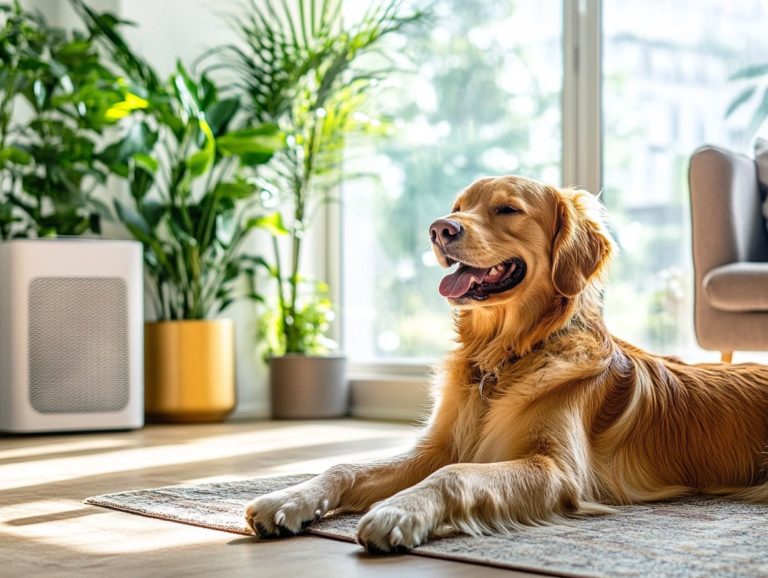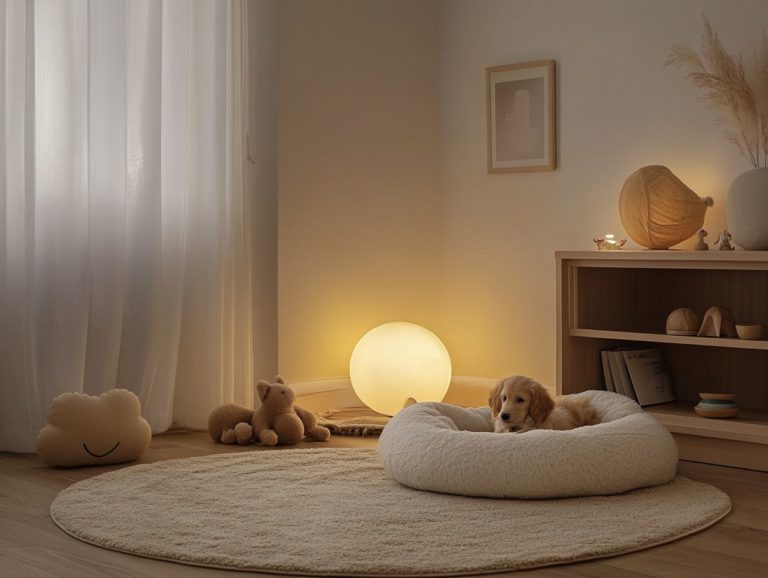Best Practices for Reducing Pet Stimulation
In today s fast-paced world, it s all too easy for pets to feel overwhelmed by a constant barrage of stimuli, from loud noises to hectic schedules.
Grasping the concept of pet stimulation is essential for ensuring the well-being of your furry companion.
This article delves into what pet stimulation really means, the significance of minimizing it, and how to recognize the signs of over-stimulation in your pets.
You ll also find effective strategies for crafting a calming environment and achieving a balanced lifestyle for your cherished companions!
Discover how you can enhance your pet s quality of life through thoughtful management of their stimulation.
Contents
Key Takeaways:

- Do you know why understanding pet stimulation is vital for a happy pet?
- Reducing pet stimulation can prevent negative effects on your pet’s behavior and well-being!
- Creating a calming environment, managing interactions, and implementing stimulation strategies can help reduce pet stimulation.
Understanding Pet Stimulation
Understanding pet stimulation is essential for you as a pet parent who wants to ensure your beloved dog thrives both mentally and physically.
Proper stimulation includes a variety of activities, such as exercise, training, and interactive toys, all tailored to match your dog’s energy level and physical needs while also safeguarding their mental health.
Ignoring these activities can cause boredom, which often results in destructive behaviors that are detrimental both to your pet and to you.
By actively engaging your dog in mental and physical stimulation, you can significantly enhance their overall well-being and cultivate a more harmonious home environment.
What is Pet Stimulation?
Pet stimulation encompasses a variety of activities crafted to engage your furry friend s mind and body, ensuring they stay active and healthy.
This goes beyond just physical exercises like walks and playtime; it also includes mental challenges that spark problem-solving skills and curiosity.
You can introduce an array of stimulating options, such as interactive toys that dispense treats. These clever devices encourage your dog to think and strategize to earn their rewards.
Training sessions help by providing mental stimulation while reinforcing good behavior. Keeping your dog engaged with this diverse mix of activities is essential to prevent boredom, which can lead to destructive tendencies.
By providing the right combination of stimulation, you nurture a happy, well-adjusted companion who thrives in your care!
Why Reducing Pet Stimulation is Important
Reducing pet stimulation is an essential facet of responsible pet ownership that can profoundly influence a dog’s mental health and overall well-being. Implementing noise reduction techniques for anxious pets can be particularly beneficial in this regard.
Over-stimulation may give rise to a range of behavioral issues, including hyperactivity, anxiety, and destructive tendencies, which can put a strain on the bond between you and your pet.
By being attuned to the signs of over-stimulation and employing effective strategies to cultivate a more balanced environment, you can create a calmer and more joyful atmosphere for your beloved dog!
Potential Negative Effects on Pets

The potential negative effects of over-stimulation on pets can take many forms, ultimately impacting their mental health and behavior.
When your pets are overwhelmed by too much sensory input whether it s loud noises, erratic movements, or constant interactions they may start to show signs of anxiety, destabilizing their emotional state.
This anxiety can lead to destructive behaviors, like chewing furniture or excessive barking, as they struggle to cope with their heightened alertness.
Ironically, even in a setting full of stimulation, they can also experience moments of boredom, resulting in restlessness and irritability.
Recognizing these behavioral issues is vital, as creating a well-balanced environment not only enhances their well-being but also fosters harmony within your household.
Identifying Over-Stimulated Pets
Identifying over-stimulated pets is crucial for you as a pet owner. It ensures your furry companion remains both healthy and happy. By recognizing the signs of too much excitement, you can prevent unnecessary behavioral issues that may arise, fostering a more balanced and serene environment.
Signs and Behaviors to Look Out For
Look for signs and behaviors in over-stimulated pets, such as hyperactivity, excessive barking, and destructive actions. These are clear indicators that your pet is yearning for a calmer environment.
These behaviors often arise from boredom and a lack of mental engagement. When pets aren t receiving the right amount of stimulation through play or training exercises, they may become restless. This can lead to frantic behavior or incessant barking in a bid for your attention.
Pets may chew furniture or scratch walls when they feel overwhelmed and struggle to channel their energy constructively. Recognizing these triggers is crucial for pet owners who wish to cultivate a balanced and nurturing atmosphere, ensuring their furry companions remain content and well-adjusted.
Best Practices for Reducing Pet Stimulation
You can transform your pet’s life with these simple best practices for reducing pet stimulation. By effectively addressing both their mental and physical needs, implementing a low-stimulation environment for pets can foster a sense of balance that enhances their overall well-being.
Creating a Calming Environment

Creating a calming environment for your dog is essential to minimize stress and anxiety. This is a vital strategy if you’re looking to reduce over-stimulation.
You can achieve this through thoughtful approaches that ensure your furry companion feels safe and relaxed. Designate a quiet space in your home, away from the hustle and bustle. This offers a perfect retreat for your dog to unwind. Incorporating soothing music or white noise can help mask disruptive sounds, crafting a serene atmosphere.
Utilizing calming aids, such as lavender-scented diffusers or anxiety wraps, can further enhance the tranquility. By personalizing these elements to suit your dog’s unique preferences and needs, you can cultivate a nurturing environment that promotes well-being and alleviates anxiety for your beloved pet.
Managing Interactions with Other Pets and People
Managing interactions with other pets and people is crucial for ensuring that your dog remains calm and well-adjusted. This significantly contributes to their overall well-being.
Organize structured playdates and control the environment to create safe spaces. Here, your dog can interact with others while minimizing any potential stressors. It s important to approach introductions gradually, giving both your dog and their new companion the time they need to acclimate to each other s presence.
Proper training is vital in these situations. It equips your dog with the necessary skills to navigate social contexts with confidence. By creating positive experiences through careful supervision and guidance, you foster better relationships and enhance your dog s comfort in various interactions.
Implementing Mental and Physical Stimulation Strategies
Implementing mental and physical stimulation strategies is crucial for keeping your dog engaged while preventing over-stimulation and the behavioral issues that can follow.
Incorporate a variety of interactive toys, puzzles, and canine sports into your daily routine. This significantly enhances the overall well-being of your furry companion. Engaging activities like agility training or scent work challenge them mentally and provide essential exercise to keep them fit.
Puzzles that dispense treats stimulate their problem-solving skills. Meanwhile, interactive toys encourage play that nurtures their natural instincts. Structured playdates with other dogs offer vital social interaction, ensuring your pet receives a well-rounded experience that balances both their mental and physical needs.
Benefits of Reducing Pet Stimulation
Reducing pet stimulation offers benefits that go far beyond just creating a serene environment. Implementing tips for reducing clutter to calm pets leads to improved behavior and enhances the overall well-being of your dog, fostering a more harmonious relationship with your furry companion.
Improved Behavior and Overall Well-Being

Reducing pet stimulation offers remarkable benefits for your dog’s behavior and overall well-being, including how to reduce foot traffic stress for pets, contributing to a happier and healthier companion.
Cultivating a more tranquil environment allows your canine friend to exhibit fewer anxiety-related behaviors, especially in breeds known for their high energy, like Australian Shepherds and Border Collies. This includes issues like excessive barking or destructive chewing.
As hyperactivity reduces, it fosters a more stable emotional state and enhances your dog’s ability to focus and think critically during training. With tension melting away, you can engage in activities like hide-and-seek or scent walks, strengthening the bond between you and your dog.
Imagine transforming your daily activities into joyful adventures! A calmer atmosphere allows stronger connections as you explore new routes together while enhancing mental health for both of you. Mindful interactions become the norm, turning your relationship into a nurturing journey with practices like scatter feeding and rotating toys that support emotional well-being for both you and your beloved pet.
The Importance of Finding Balance for Your Pet’s Stimulation Needs
Finding the right balance in your pet’s stimulation needs, particularly through enriching games for dogs like fetch, is essential for ensuring they are both mentally and physically fulfilled, which is vital for breeds like Border Collies.
This balance helps prevent negative behaviors stemming from boredom or over-excitement, especially in pets like Australian Shepherds. Understanding that dogs thrive when their mental and physical needs are met enables you to create a harmonious environment.
Engaging your dog in a variety of activities like interactive play, including fun activities such as find-it games, and thinking games nurtures their natural curiosity while promoting physical health. Resources like PetMD can provide valuable insights on these practices.
This interplay is vital; when your canine companion receives adequate mental stimulation through diverse activities, it can significantly reduce their stress and anxiety levels. This makes it easier for pet parents to manage their pets’ needs effectively.
On the flip side, regular physical exercise, such as walks or a good game of fetch, helps release pent-up energy, allowing your dog to feel calm and centered. By recognizing and fostering this balance, you can enhance your pet’s overall well-being and happiness, contributing to a stronger relationship.
Frequently Asked Questions
What are the best practices for reducing pet stimulation?
- Limit exposure to triggers: Identify what triggers your pet’s excitement or hyperactivity and limit their exposure to it as much as possible. This could be certain noises, toys, or other animals.
- Provide mental and physical stimulation: Ensuring your pet gets enough mental and physical exercise can help reduce their overall energy levels and prevent them from becoming overstimulated.
- Establish a routine: Pets thrive on routine and structure, so establish a daily routine for them that includes designated playtime and quiet time.
- Use calming aids: Consider using calming aids such as a Thundershirt, calming pheromone diffusers, or natural supplements to help ease your pet’s anxiety and reduce stimulation.
- Practice positive reinforcement: Reward your pet for calm and relaxed behavior, and avoid reinforcing excitement or hyperactivity.
- Seek professional help: If your pet’s stimulation levels seem unmanageable or are causing behavior issues, seek guidance from a professional trainer or behaviorist.
By implementing these best practices, you can create a calmer environment for your pet, leading to a more fulfilling and enjoyable life together. Start today by observing your pet’s needs and making small adjustments to their routine!






